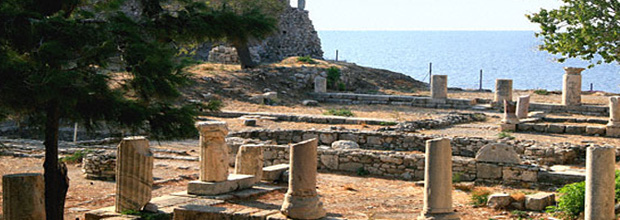CIVILIZATION OF SAMOS
Aristarchos the Samios was a famous astrophysicist and a great astronomer, who expressed the theory concerning the movement of the Earth. The Polish astronomer Copernicus later studied his writings, in order to formulate the Copernicus system according to which the earth and the stars move around the sun.
In the area of sculpting ,the sculptors Poikos and Theodoros ( 6th-5th cent.) invented the production of molded or cast cooper statues using a clay model and the sculptor Pythagoras that is said to be the creator of Iniochos of Delphi. While during same period, lived the stamp-sculptor named Mnisarchos, father of the famous philosopher and mathematician Pythagoras.
In the area of painting, the painter Savrias stands out and as he was the first who devised the shading of paintings. In the area of archeology the unique Mandioklis (513 b.c.) that created the floating bridge on the Bosporus and in the area of hydraulic mechanics the in famous Evpalinos with his famed Evpalinio Origma at Pythagorio.
In the area of shipping, a new type of ship with 50 oars known as the Samaina was constructed here for the first time. As part of the Cyclades culture the island contributed in its promotion and development.
During the Neohellenic years the island cultivated many artists, scientists and scholars, but not as significant as those of the ancient Samions. The Aegean traditional architecture, the painting and sculpturing techniques and pottery follow the pattern that was apparent on all the islands of the Northeastern Aegean.
At the archeological museum findings from Iraion are exhibited. The constitution of the Samion sculptor Geneleo, the torso of Kouros of Lefkia, sculptures and statues from the Hellenistic period, a collection of cooper objects from Egypt and Persia, clay objects from Cyprus, prehistoric vases and ceramic from the Geometrical and Archaic Period.
At the Ecclesiastic and Byzantine museum, there is a vast collection of gold and silver works, golden weaved embroidery and manuscripts on membrane. At the folkloric museum you will have the possibility to admire pictures inspired from the traditional life of the island, hand woven embroidery, loom and spindle articles.
Finally don't forget to visit the Paleontology museum, which was created by the professor of paleontology at the Aristotle University, John Melentis with the economic contribution of Constantine and Maria Zimalis. There you will find fossils of animals that lived on the island and are dated back millions of years that came to light in 1963.
You will also find fossilized bones from civilized species of a pony and small sized elephants and rhinoceros. These animals existed in the surrounding area before the Aegean Sea was formed by geological realignments.

View offers in selected studios and apartments in Samos island
Find the perfect place for your accommodation in Kythera and enjoy your vacations in Greece
Contact us for questions and information about samos-island.info